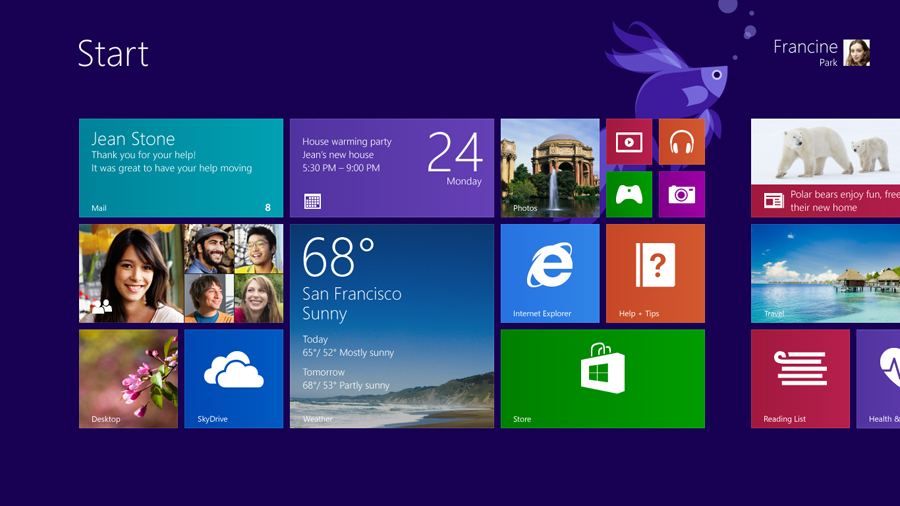What Windows 9 could bring in terms of features and improvements
Hopes and expectations

Update: Windows 9 is now known as Windows 10. Want to know more about when you can get your hands on it? Check out our in-depth Windows 10 release date page
From what I have gleaned so far, it looks as though Windows 9 offers some positive benefits for enterprises over Windows 8, although there will be a few checks and balances that organisations will need to make, particularly in the often thorny area of security.
We will see a return to a more desktop-focused environment, meaning that Windows 9 will be much closer in design to Windows XP/7 than Windows 8. This will make the traditional desktop easier to configure and use than Windows 8's default Metro interface.
There are a few APIs marked as deprecated in Windows 8 that we can probably expect to see removed in Windows 9 and replaced altogether. What is unclear at this stage is how much of an impact this will have on application compatibility.
I doubt that we will see another XP-Windows 7 migration scenario: it's likely this will be more of an iterative than transformative transition, which bodes well for enterprises.
The Windows store will point to a corporate internal app store. This will come into its own only when it's populated with corporate applications.
Check our TechRadar's coverage of Windows 9 so far
Get daily insight, inspiration and deals in your inbox
Sign up for breaking news, reviews, opinion, top tech deals, and more.
However this raises the question of how many enterprise environments will make the leap to self-service published applications - and the associated expansion of licensing costs. Another factor to consider in this scenario is how to effectively control application spread within the organisation.
The Start Menu is back in Windows 9 and the start screen is gone - at least for desktops. The Windows 8 Charms bar is going and will be replaced with an additional window control in the top right, although I imagine that this would only be used for Metro apps. In addition, accessing multiple desktops will become easier using Windows 9, making it easier to categorise workspaces by tasks and easily flick between them.
The Windows key is still the recommended way to start applications. Microsoft continues to promote the flat graphical style with Metro applications and is aiming to maintain the same Metro user interface metaphors across phones, tablets and desktops.
There's a notifications bar adding a phone-style list of things that have recently happened on the system: new messages, hardware insertions, available updates, etc. to the system notification area. These will all be of benefit to enterprises.
Maintenance and management will still be through GPOs (Group Policy Objects) as in almost all enterprise environments.
The update methodology appears to be constant incremental tweaking rather than gold image, patch cycles and service packs. This should improve management/update capabilities in the enterprise.
Microsoft may also choose with Windows 9 to introduce the Cortana personal assistant (Microsoft's version of Apple's Siri) to Windows devices other than Windows phones.
As with Siri, Cortana will take requests and questions using voice recognition. You can ask Cortana to do simple things, like setting alarms and calendar appointments, as well as ask it to alert you about likely events and schedules based on patterns of usage and by place-watching your contacts, appointments and other information. However I'm not sure how useful or functional this would be in a busy office environment in a fixed location.
Finally, a desirable additional feature would be enhanced integration between the Metro and desktop versions of Internet Explorer to aid in the sharing of favourites/bookmarks/history etc. We will have to wait and see whether this is forthcoming.
There will be the capability within Windows 9 to store data in a variety of ways: locally, on the network and in the cloud. Storage spaces will show your collected storage in one consolidated view, regardless of where the data is actually stored.
The flexibility here is good, but how this is deployed by enterprises is uncertain. Enterprises will first need to set in a place a number of important measures in order to ensure that configurability and security are not compromised.
Windows 9 also goes further than previous OS in a bid to entice people into a Microsoft ecosystem outside of work, with its focus on linking people in via Xbox, Microsoft Outlook, and the cloud.
This is another area where we expect to see access controls put in place by enterprises to minimise the risk of any security glitches involving corporate data.
Finally, it would seem that the Windows close/minimise/maximise buttons will be present on the metro apps, allowing them to coexist with true desktop applications. As yet though, there is no information on how much copying/pasting or data sharing will be possible between the different styles of applications.
In conclusion, I believe that Windows 9 will bring in a lot of positive enhancements for enterprises for the future. However, given that many enterprises are only now in the process of migrating from XP to Windows 7, it will be a while before Windows 9 adoption becomes mainstream.
- Damian Dwyer is Practice Director, End User Computing Practice at British IT consultancy ECS.